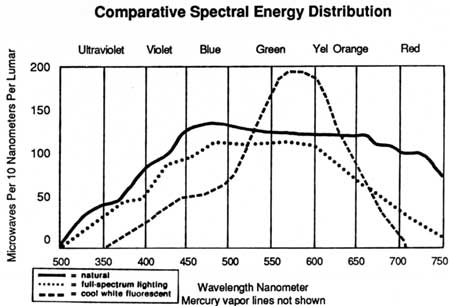
| Letters of the Institute for domestic Tranquility | Washington • 1988 | Volume 3 • Number 1 |
The Ott-Certified Full Spectrum Radiation Shielded Lighting Fixture
Full spectrum, radiation shielded lighting fixtures simulate the visible and long wave ultraviolet elements of the electromagnetic spectrum of natural sunlight, while shielding any harmful radiation.
Dr. John Ott, a pioneer in studying the effects of light on plants and animals, has designed a lighting fixture which provides the benefits of full spectrum light with a separate long wave ultraviolet (UVA) source. The fluorescent tubes have lead foil at both ends to shield users from the near X-ray cathode radiation normally emitted from them. Research on malignant melanoma has correlated this deadly form of skin cancer with exposure to fluorescent lighting. Since the ultraviolet light given off by normal fluorescent lights is minimal and long wave (UVA), and therefore not related to cancer, a possible explanation for melanoma is this cathode radiation. The fixture also comes with a wire mesh shield to ground any radio frequency waves generated by the alternating current which powers the lights. Finally, where the lights are to be used in close work or for reading, since light flicker is a primary factor in eye fatigue, solid state ballasts replace the commercial variety and eliminate flicker by increasing the frequency beyond the range of human perception.
These full spectrum, radiation shielded fixtures are available through Environmental Systems Northeast, HCR 65, Box 27, Sharon, Vermont 05065.

The Constitution
"We hold These Truths: Understanding the Ideas and Ideals of the Constitution" by Mortimer J. Adler, is the only philosophical book written for the lay public about the Constitution. It was published by MacMillan, March 20, 1987.
Adler examines what he calls "the American Testament"—the Declaration of Independence, the Constitution, and the Gettysburg Address. In the first part of the book, Adler defines and discusses the ideas found in the core of the Declaration of Independence: the pursuit of happiness, consent and dissent of the governed, human equality, etc. In Part Two he examines ideas found in the Preamble, such as justice, the general welfare, domestic Tranquility, etc. Parts III and IV deal respectively with the defects of the Eighteenth century Constitution and the emergence of democracy in the Twentieth century.
The book contains the full texts of the documents and an appendix with the most significant passages from the records of the Constitutional Convention, the Federalist and Anti-Federalist papers, historical commentaries and Supreme Court decisions.
IdT caught my eye. If any of you read this book tell us about it. It seems like it might be worth a review in the context of ecology.
. . . Ed Hessler . . .
Information Age Library
In a rural part of Prince George's County, MD, not far from the Capitol Beltway, and information age library is taking form. According to the Washington Post for October 6, 1987 the first construction on the site, a 40,000 square foot facility, will house the computer for the whole system.
The Washington Library Consortium, consisting of American, Georgetown, George Washington, George Mason, Catholic, Gallaudet, and Marymount universities, and the University of the District of Columbia is building the 21 million dollar facility to link the 8 universities, 160,000 students and 3800 faculty to the collection of 16 million books, manuscripts, magazines, journals, maps and other library holdings.
Each university will maintain its own library, however electronic catalogues will be uploaded into the central computer in Prince George's County. An estimated 1200 terminals will tie the system together with its users and a fleet of vans will guarantee next day delivery of any book in the system to any user in the system. The central facility will house little used and rare books, freeing up space in each of the participating university's libraries. The central facility will also house a conservator's facility to repair and restore valuable manuscripts and will contain work space for researchers. One can easily imagine a number of such facilities binding together local university and research libraries in various parts of the country. It would be a simple but a giant step to connect all the central computers of these local networks into a single national library system.
The cost of each central library facility to house the computer, the rare and obscure books and the researchers would be shared by the Federal government and the participating universities. The U.S. Department of Education, for instance, will put up 7 million dollars of the Prince George's County facility. The CIA and the Library of Congress should design, fund and operate the central switch.
A system of vans is not feasible for next day delivery in the national system, but Federal Express, the U.S. Postal Service Express Mail, the UPS Overnight Delivery, etc. are. And the old fashioned interlibrary loan system would work very well for those of us who could wait.
A National Library as an ecological system of libraries might be nearer than we think.
. . . Ted Sudia . . .
© Copyright 1988
Institute for domestic Tranquility
Teach Ecology • Foster Citizenship • Promote Ecological Equity
